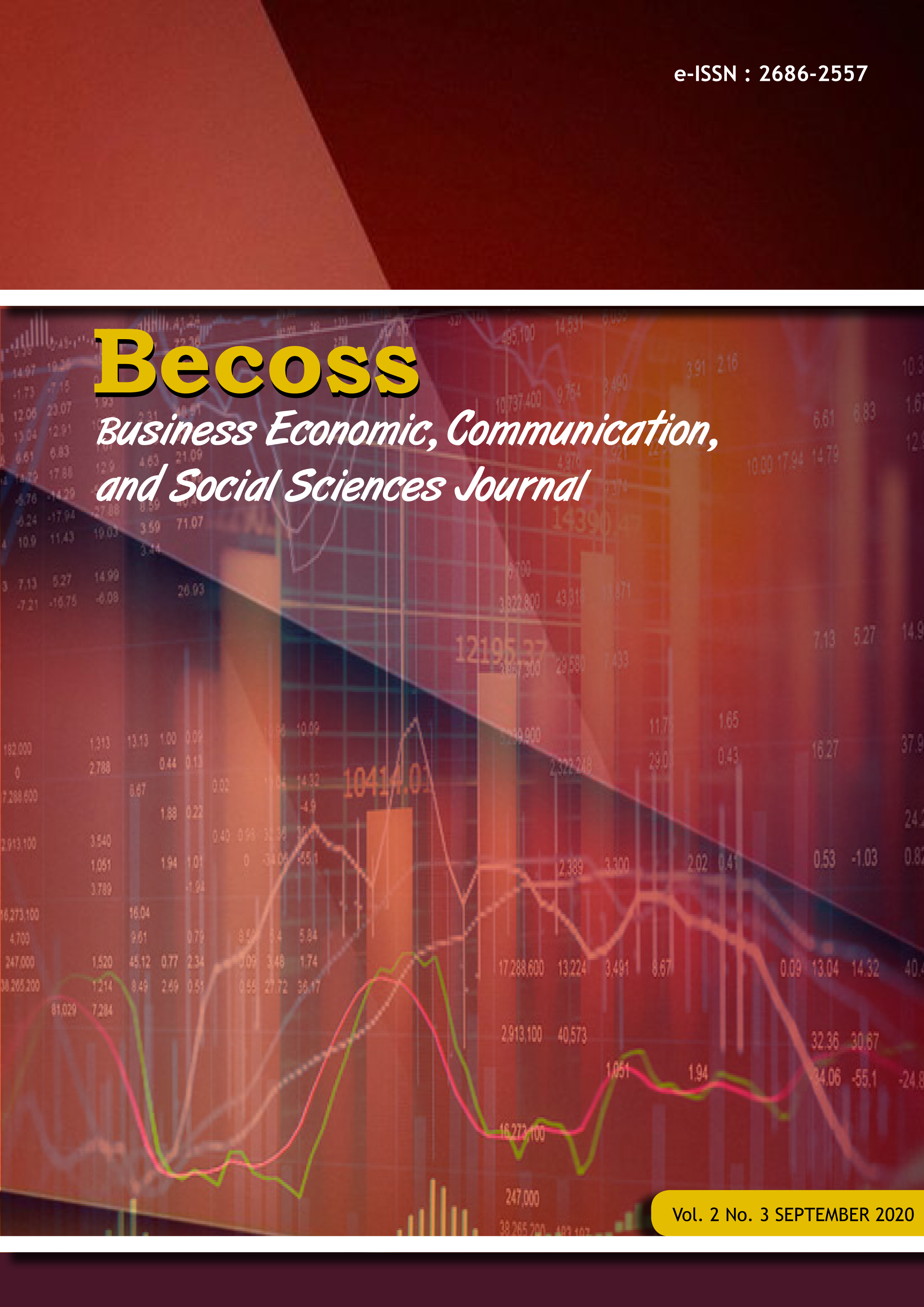Optimalisasi Ekspor Produk Ekonomi Kreatif Indonesia Menuju Peningkatan Dayasaing
DOI:
https://doi.org/10.21512/becossjournal.v2i3.6658Keywords:
Optimization, creative economy, fashion productsAbstract
Indonesia’s creative economy product exports have not been optimal. The purpose of this study is to optimize the goals of creative economic development in Indonesia. This research was conducted using secondary time series data for the period 2010-2017. The research method uses linear programming and goal programming. The results showed that exports of creative economy products responded to an increase in export selling prices based on the demand behavior of the exports of creative economy products. The factor of export competitiveness of Indonesia’s creative economy products lies in the use of cheaper labor costs. Exports of creative economy products do not automatically increase, if the education level of the workforce increases, but rather comes from an increase in creativity. Fashion products are efficient products compared to producing exports of craft products and culinary products. Finally, the development of the creative economy is more optimal for the purpose of increasing exports of creative economy products than for the purpose of increasing employment, namely by producing fashion products.References
Badan Ekonomi dan Kreatif [BEKRAF]. (2018). Data Statistik dan Hasil Survey Ekonomi Kreatif. Kerjasama Badan Ekonomi Kreatif dan Badan Pusat Statistik, Jakarta.
Badan Ekonomi dan Kreatif [BEKRAF]. (2017). Data Statistik dan Hasil Survey Ekonomi Kreatif. Kerjasama Badan Ekonomi Kreatif dan Badan Pusat Statistik, Jakarta.
Badan Ekonomi dan Kreatif [BEKRAF]. (2017). Ekspor Ekonomi Kreatif 2010-2016. Kerjasama Badan Ekonomi Kreatif dan Badan Pusat Statistik, Jakarta.
Badan Ekonomi dan Kreatif [BEKRAF]. (2017). Upah Tenaga Kerja Ekonomi Kreatif 2011-2016. Kerjasama Badan Ekonomi Kreatif dan Badan Pusat Statistik, Jakarta.
Belete, W. (2016). Policy Modalities for Support of Ethiopia’s Creative Industries. The African Journal of Information and Communication (AJIC), 19, 59-77.
Daubaraite, U. and G. Startiene. (2015). Creative industries Impact on National Economy in Regard to Sub-sector. 20th International Scientific Conference Economics and Management-2015 (ICEM-2015), Procedia-Social and Behavioral Sciences 213(2015)129-134, Elsevier.
Dunska, M. and A. Marcinkevica. (2017). Situation and Development Opportunities of Creative Industries Companies in Latvia. Eurepean Research Studies Journal, Vol.XX, Issue 3A, 2017, pp:96-114.
Fathurrahman, H. and M. Huseini. (2018). Mapping of Regional Economic Potential Based on Creative Economy to Support Creation of Regional Competitiveness. Knowledge and Social Transformation, vol. 2018.
Heizer, Jay and Render Barry. (2011). Operations Management. Prentice Hall. New Jersey.
Kontrimiene, V. and B. Melnikas. (2017). Creative Industries: Development Process Under Contemporary Conditions of Globalization. Business, Management and Education, 15(1):109-126.
Lindo Systems Inc. (2008). LINGO User’s Guide. Lindo System Inc., Chicago.
Potts, J.D. (2009). Why Creative Industries Matter to Economic Evolution. Economics of Innovation and New Technology, 18(7-8), pp.663-673.
Septri, W. dan I. Krisnadi. (2019). Pemanfaatan Big Data dalam Perkembangan Ekonomi dan Bisnis di Indonesia. Jurnal Manajemen Bisnis dan ICT Universitas Mercu Buana Jakarta, Januari 2019.
Skavronska, I.V. (2017). Creative Industries in Ukraine: Analysis and Prospects of the Development. Economics and Sociology, Vol. 10, No. 2, pp.87-106.
Sukma, M., D. Hartono, and S. Prihawantoro. (2008). The Impacts Analysis of Creative-Products Export on the Economy. Jurnal Ekonomi dan Kebijakan (JEJAK), Vol 11(1) (2008):92-107.
Downloads
Published
How to Cite
Issue
Section
License
Copyright (c) 2020 Business Economic, Communication, and Social Sciences (BECOSS) Journal

This work is licensed under a Creative Commons Attribution-ShareAlike 4.0 International License.
Authors who publish with this journal agree to the following terms:
- Authors retain copyright and grant the journal right of first publication with the work simultaneously licensed under a Creative Commons Attribution License - Share Alike that allows others to share the work with an acknowledgment of the work's authorship and initial publication in this journal.
- Authors are able to enter into separate, additional contractual arrangements for the non-exclusive distribution of the journal's published version of the work (e.g., post it to an institutional repository or publish it in a book), with an acknowledgment of its initial publication in this journal.
- Authors are permitted and encouraged to post their work online (e.g., in institutional repositories or on their website) prior to and during the submission process, as it can lead to productive exchanges, as well as earlier and greater citation of published work.
USER RIGHTS
All articles published Open Access will be immediately and permanently free for everyone to read and download. We are continuously working with our author communities to select the best choice of license options, currently being defined for this journal as follows: Creative Commons Attribution-Share Alike (CC BY-SA)






